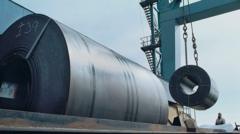The latest 50% tariff on steel and aluminum is expected to significantly affect industries like home construction and automobile manufacturing, leading to increased costs for consumers while some domestic producers applaud the move.
Rising Tariffs Reshape U.S. Industry Landscape

Rising Tariffs Reshape U.S. Industry Landscape
President Trump's recent tariff increases on steel and aluminum imports spark debates across various sectors in the U.S.
President Trump has announced a drastic increase in tariffs on steel and aluminum imports, now reaching 50%, just months after instituting a 25% tariff. This decision, made public recently, aims to bolster U.S. steel manufacturers, but critics from various industries caution that it could lead to higher prices for end consumers across multiple sectors.
Key industries impacted include home building, vehicle production, and beverage can manufacturing. Experts suggest that these companies might be forced to pass the increased material costs onto their customers. Mary E. Lovely, a senior fellow with the Peterson Institute for International Economics, cautioned, "It means higher costs for consumers," highlighting the potential broad financial implications.
On the flip side, American steel manufacturers, represented by groups like the American Iron and Steel Institute, have expressed approval of the tariff hikes, arguing that they enhance competitiveness against foreign competitors, particularly from China. Kevin Dempsey, the institute's president and CEO, noted that the heightened tariffs could catalyze investment and job creation within the domestic steel sector.
The initiative reflects a pivotal moment in the ongoing conversation surrounding U.S. trade policies and their ripple effects on both consumers and businesses, emphasizing the dual edged nature of protective tariffs in stimulating domestic growth while potentially burdening consumers through increased prices.






















